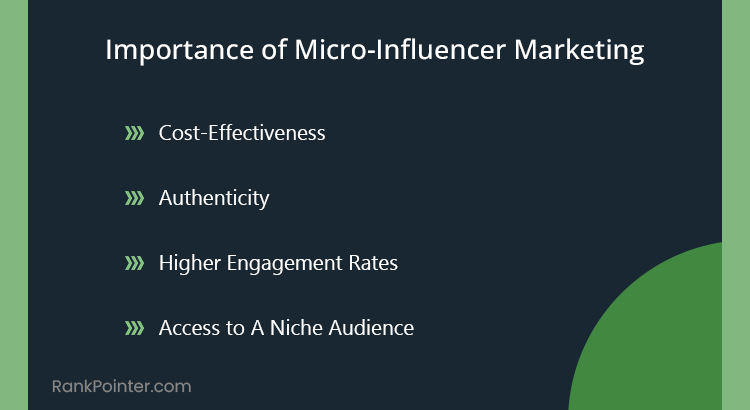Micro-influencer marketing presents a compelling strategy for businesses operating within constrained marketing budgets. Micro-influencers hold a significant portion of the influencer market, so there are plenty of creators to work with.
But why should brands consider teaming up with micro-influencers, and what exactly defines this category? This beginner’s guide to micro-influencer marketing offers a comprehensive resource for your brand to seamlessly embark on this strategy.
Related Article: Influencer Marketing: Strategies and Benefits
What is a Micro-Influencer?
A micro-influencer is similar to any other influencer, but on a smaller scale. These individuals wield influence over a dedicated, niche audience ranging from 10k to 50k followers.
Micro-influencers, much like their larger counterparts, leverage their social media platforms to promote products, services, or brands in exchange for compensation, whether monetary or in-kind.
From Instagram to YouTube, micro-influencers can be found across various social media platforms, catering to specific interests and niches.
Importance of Micro-Influencers in Your Marketing Campaign
1. Cost-Effectiveness
Micro-influencers offer an affordable alternative to macro or mega influencers, making them ideal for small brands.
By working with multiple micro-influencers, brands can maximize their marketing budget while reaching a diverse audience, driving engagement and conversions.
2. Authenticity
Micro-influencers’ expertise in specific niches fosters authenticity in their endorsements.
Their genuine insights and personal connections with followers create more meaningful interactions, enhancing brand credibility and trust among their audience.
3. Higher Engagement Rates
Micro-influencers, with their niche audience and loyal following, often achieve higher engagement rates compared to macro influencers.
Their ability to connect intimately with followers fosters genuine interactions, resulting in increased brand awareness and customer loyalty.
4. Access to A Niche Audience
Partnering with micro-influencers allows brands to reach niche audiences that align with their products or services.
These passionate and engaged audiences offer valuable opportunities for targeted marketing, driving brand visibility and conversions within specific industries.

How to Work with Micro-Influencers?
Here’s a step-by-step guide on how to effectively collaborate with micro-influencers and ensure success in your marketing campaigns:
Step 1: Pinpoint your goals and objectives
Before diving into your micro-influencer marketing strategy, it’s crucial to outline your overarching goals and objectives. Consider the following common goals of influencer marketing:
- Elevating brand awareness
- Boosting brand mentions
- Growing social media followers
- Increasing website traffic
- Generating new sales
Decide which objectives align best with your brand’s current needs and objectives. Keep in mind that your chosen goals will shape the content and promotional materials your influencer partners create, so ensure they’re in sync with your overarching strategy.
Step 2: Find the right micro-influencers for your brand
To begin your search for influencers, utilize these methods:
Manual Search
Explore social media platforms by keywords, filtering accounts relevant to your industry. Compile a list of potential influencers aligned with your brand’s mission and products.
Review Your Follower List
Examine your existing followers for potential micro-influencers who are already engaged with your brand.
Engage with Agencies
Consider partnering with influencer marketing agencies for expert assistance in selecting the best influencers for your campaign. These agencies specialize in pairing brands with suitable influencers and can provide valuable insights and guidance.
Step 3: Choose the best types of content for your influencer partners to create
Once you’ve identified your influencers, it’s time to decide on the most effective content types for your campaign. Consider the following suggestions:
Determine which platforms are best suited for your campaign. Facebook, Instagram, TikTok, and YouTube are popular choices for influencer marketing.
Content Ideas:
- Provide influencers with creative content ideas such as:
- Showcasing your product in an unboxing video
- Leveraging Twitter for text-based posts that highlight your brand
- Sharing brand stories or product experiences through Instagram carousels
- Creating branded hashtags to increase brand visibility
- Offering affiliate promo codes to drive sales
- Demonstrating product tutorials for their audience
- Hosting a giveaway with a micro-influencer
- Creating engaging micro-videos for platforms like TikTok and Reels
Ensure that your content ideas align with your campaign goals and objectives. For example, focus on increasing brand awareness with engaging content like unboxing videos, while leveraging discount codes to drive sales.
Step 4: Tell your brand story through micro-influencer content
Integrating your brand’s narrative into micro-influencer content enhances authenticity and resonates deeply with their audience.
By sharing your brand story, micro-influencers establish a genuine connection, fostering trust and credibility, ultimately driving engagement and potential purchases.
Provide influencers with comprehensive documentation containing your brand’s story, mission, and key messaging points to effectively convey your brand’s identity and values.
Closing Thoughts on Micro-Influencer Marketing
Micro-influencer marketing presents an enticing opportunity for brands to connect with niche audiences authentically. By understanding the essence of micro-influencer partnerships and harnessing their storytelling skills, brands can fully capitalize on influencer marketing’s effectiveness.


